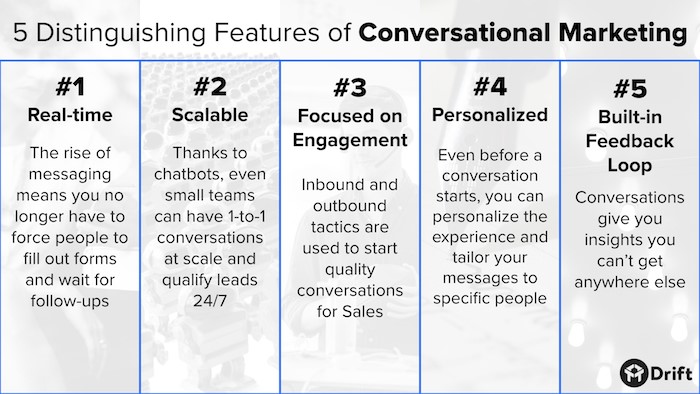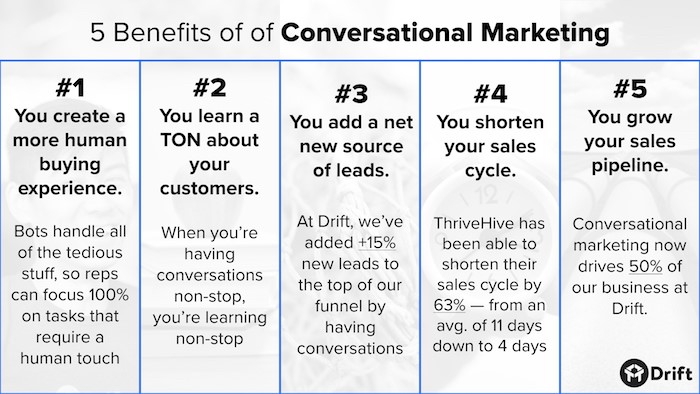
“Hey”, you ask, “Doesn’t all successful marketing require a positive exchange between buyer and seller? Something you might call ‘a conversation’?”
Yep.
A smart guy named Erik Devaney of Drift Inc. suggests this: what’s broken is the means to the way we’ve been doing marketing and sales on the web.
But, he adds, not irreparably. Your question shows you already know how to fix it: make business personal again.
So that’s exactly what Devaney’s firm is doing: putting one-to-one communication and dialogue back at the heart of on-line marketing. They call it Conversational Marketing.
“Conversational Marketing” Defined.
It is a one-to-one approach to on-line marketing that companies use to shorten their sales cycle, learn about their customers, and create a more human buying experience.
Unlike web marketing that has become “traditional” in the past decade, conversational marketing uses targeted, real-time messaging and intelligent chatbots instead of lead capture forms, ensuring leads never have to wait for follow-ups, and can engage with your business when it’s convenient for them (like when they’re live on your website).
Devaney notes “conversations with potential customers don’t just happen on your website, which is why conversational marketing is bigger than any single channel or platform.”
Conversational marketing combines inbound and outbound tactics in real time to start a dialogue with the people who can benefit from your offer. It’s not just a one way blast from you ending with what might be a blunt call-to-action that too often leads to just a “yes” or “no” option for the prospect to consider. We all know it’s much easier to say “no”.
With the support of intelligent chatbots that can answer or quickly redirect enquiries 24/7/365 Drift’s technology supports marketers’ live customer service personnel by helping answer people’s questions, listening to their feedback, and then uncovering new ways to help them.
What happens is an actual conversation. It’s the way most customers prefer to buy.
All too often today that is not what happens early enough in the process.
Why?
- Since the advent of search engines like Google we’ve become obsessed with tracking and measuring every metric imaginable: hits, clicks, emails, dials, and so on.
- We’ve become so focused on things like A/B testing, retargeting, email blasts, robocalls, form fills, marketing-qualified leads and sales-qualified leads that we’ve lost track of what really matters.
Being data-driven became more important than being customer-driven.
As a result, the buying experience most companies provide has become cold and impersonal. For many marketing and sales teams, their leads have become faceless entities that exist only inside of spreadsheets — they aren’t treated like actual people.
It can be a terrible experience for potential customers. And it’s bad business.
Devaney says only 43% of people answer cold calls, and the average email open rate is about 20%, and the average landing page conversion rate is just 2.35%.
Business can do better. Let’s have a conversation about it.
Consider These Features of Conversational Marketing.
- Real Time.
Instead of forcing people to fill out static lead forms and wait for follow-ups (that might never come), conversational marketing focuses on engaging people in real-time, both with human-to-human conversations and human-to-chatbot conversations.
Thanks to the rise of intelligent chatbots, anytime a potential customer asks a question, your company can now be there to provide a real-time response — 24/7/365. Same goes if a potential customer wants to a book a demo with a sales rep. A chatbot can take care of scheduling that anytime, day or night.
Remember: it’s not about replacing human-to-human interactions (those are definitely still the best kind!), it’s about making sure your potential customers get their questions answered as quickly as possible. Because ultimately, if you can’t provide an answer to someone’s question right away, that person is going to go ask someone else — possibly a competitor.
That’s just the nature of the on-demand, real-time world that we live in these days, where everything seems to be one click away. Conversational marketing was born out of this real-time world, and is the only marketing methodology that’s adapted to it.
- Scalable.
Marketing and sales teams have known about the power of one-to-one conversations for decades, (centuries?) but there’s always been one lingering problem:
“Having one-to-one conversations doesn’t scale.”
That’s why teams have been locking up conversations behind “Contact Us” forms. Because marketers and salespeople just don’t have the bandwidth to talk to every lead who drops by the site…right?
Back before the rise of real-time messaging and chatbots, scaling conversations was a hard nut to crack. Because in order to have 100 one-to-one conversations with leads simultaneously, you’d need to have 100 employees dialing and smiling.
With the rise of messaging, which has been popular with support teams for years, a single employee gained the ability to manage multiple, concurrent one-to-one conversations.
And now with the rise of chatbots, the ability to scale conversations has reached unprecedented levels — which is why conversational marketing is starting to take off.
A single marketer can now set up a chatbot that automatically greets hundreds or thousands of visitors and asks them qualifying questions. That bot can then route qualified leads to specific sales reps (based on territory/ownership in Salesforce) or help those leads book demos on a rep’s calendar. It’s like you’re opening up a fast lane for your best leads.
- Focused on Engagement.
It’s traditional to measure Marketing teams on how many leads they capture via lead capture forms, or how many MQLs they generate.
With conversational marketing, business actively engages people in conversation. Instead of Lead capture forms, MQLs, you seek CQLs: conversation-qualified leads. People you actually talk to who tell you, “Hey, I’m interested in your product and want to learn more.”
Of course, inbound leads are always important. By setting up well targeted welcome messages to specific visitors, you can make sure no leads are slipping through the cracks.
Conversational marketing can include outbound tactics, too. Wherever there’s a conversation with a potential customer to be had, you should be having it. And that’s not limited to your website.
With email, for example, you can proactively reach out to a lead and get the conversation started. The difference is that instead of blasting that person with a generic message, you’re crafting something personalized and — by including a link that triggers a chatbot — you create the opportunity to start a real-time conversation if they want to.
- Personalized.
With conversational marketing, every interaction you have with a lead has context, because your team can always reference previous conversations.
But even when you’re talking to a lead for the very first time, you can add a personalized touch.
At the most basic level, you can customize the conversations you’re having on different pages of your site. For example, when a lead is on your pricing page, you can have a welcome message automatically appear that says, “Hey, this is [your name], I see that you’re checking out our pricing page. Let me know if you have any questions.”
But that’s really just the tip of the iceberg.
With enriched data, you can tailor messages based on specific information about companies (a.k.a. firmographics) as well as the specific tools they’re using (a.k.a. technographics).
You can even surface the name of the company a visitor works at via IP address matching and insert it into a message. Alternatively, once you learn the company a lead works at, you may choose to reference some of their competitors in your message, or other companies in their industry. The goal is to grab their attention and to convince them that you’re worth having a conversation with.
- Built-in Feedback Loop.
Too many companies do marketing and sales like Mad Men.
They sit in closed rooms, cut off from customers, and dream up how they can attract new customers. They’re company-driven, putting more value on internal stakeholders’s ideas than the feedback of actual or potential customers.
With conversational marketing, the customer feedback loop is built in. Because with every interaction, you’re giving leads and customers the opportunity to share their opinions.
Most people think “selling” is the same as “talking”. But the most effective salespeople know that listening is the most important part of their job. — Roy Bartell
Feedback is like a battery that powers your marketing and sales decisions. It has positive and negative sides, but you need both positive and negative feedback in order to figure out what’s working and what isn’t.
(Pssst. Need help figuring out what to do with customer feedback after you collect it? Ctrl-Click on this link customer feedback framework from Drift’s CEO David Cancel.)

“So,” you wisely note “great Features. But what about the Benefits of Conversational Marketing?”
Good point. That’s really what people buy.
These are the key benefits I recommend you consider.
- You create a more human buying experience.
Back in the “old days”, your website was like an empty store. Shoppers could walk in but there was no one there to greet them. Sorta like the old Consumers Distributing model. Remember them? Long gone.
In contrast, with conversational marketing, you have friendly salespeople out in the aisles who let all the shoppers know that they’re available to help and answer questions.
With conversational marketing, you actually say “hello” to the people who take the time to visit your site and learn more about your product. And you allow those people to start conversations with you when it’s convenient for them.
Chatbots help make conversational marketing possible, but don’t replace human-to-human conversations outright. They help buyers have the right conversations with the right people at the right times (when it’s convenient for them, not your sales team). It might sound counterintuitive, but Chatbots actually help marketing and sales teams create and deliver a more human experience.
- You learn lots of useful stuff about your customers.
Lead capture forms are good at collecting contact info, but what they’re not good at is providing context… Why did that person decide to come by the site in the first place? What’s their biggest pain point? What product feature are they most excited about?
Sure, you could ask any question you want with a form, but it will never deliver the same insights you can get from having an actual, one-to-one conversation.
To illustrate: Harvard Business Review interviewed Rapidminer CMO Tom Wentworth about how A.I. (as developed by marketing experts like Drift Inc.) is poised to streamline marketing and sales.
Every day, Wentworth reviews conversations people have had with Drift. “I’ve learned things about my visitors that no other analytics system would show,” said Wentworth. “We’ve learned about new use cases, and we’ve learned about product problems.” This is the strength of an AI agent that can elicit information like a person, rather than an analytics tool that simply finds patterns in the data it collects, like a machine.
- You add a net new source of leads.
Speaking of Drift, Devaney says “we’ve added 15% more leads to the top of our funnel using conversational marketing. Those are leads we would’ve missed out on if we had only been using the traditional, form-and-follow-up approach.”And, he adds: “RapidMiner (at this time of writing) has generated more than 4,000 leads using our conversational approach.”
- You shorten your sales cycle.
The leads Drift generates via conversational marketing (CQLs) close more quickly than traditional leads. On average, it takes just three days from an initial conversation with a lead to the time they deliver a demo to that lead.
ThriveHive, another conversational marketing convert, has seen their leads close at twice the rate of leads from other sources. Overall, ThriveHive’s sales cycle for leads sourced from conversations is 63% shorter than their typical sales cycle.
- You grow your sales pipeline.
While they only represent 15% of the leads Drift says they’ve generated, Devaney says |leads from conversational marketing drive 50% of our business”. That’s half their business.
Another of their clients credit conversational marketing, TreeRing’ says the value of business in their opportunity pipeline has increased by 10%.
And RapidMiner’s open sales pipeline has grown by 25% this year— worth more than $1 million—thanks to conversational marketing.
Does all that answer your question about the benefits of Conversational Marketing? Here’s a handy summary of those benefits.

By giving people the option to skip the form and have a one-to-one conversation, you help to make buying and selling for mutual gain personal again.
And that’s what Conversational Marketing is all about.
By Mike Hanson
No BS B2B Copywriter
Cel/Text (416) 200-2430
With thanks to Erik Devaney of Drift Inc.
